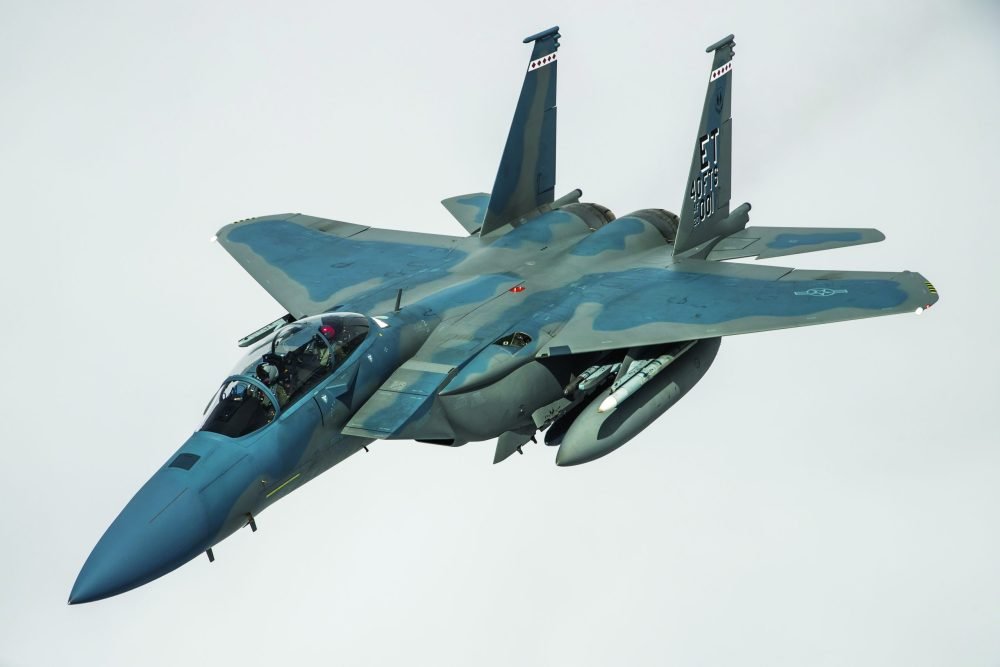As the Indian Air Force seeks to upgrade, modernise and replenish its dwindling fighter fleet, India is under increasing US pressure to choose between Lockheed Martin’s F-21 and Boeing’s F-15EX for its Multi-Role Fighter Aircraft (MRFA) programme, an essential component of the IAF’s modernisation strategy. The mounting pressure comes at a delicate time when trade negotiations between the two countries are ongoing, with the US hinting that India could receive trade benefits if it decides to buy American fighters.
At the same time, new developments in global fighter jet programmes, particularly in Europe, are opening up fresh opportunities for collaboration, which could align with India’s long-term ambitious plans for air superiority. With these developments unfolding, India must weigh its strategic options carefully to solidify its position as a leading aerospace power.
MRFA Choices
The MRFA programme is critical for the IAF because it seeks to replace its ageing fleet with modern, multi-role fighter aircraft capable of performing a wide range of combat operations. The United States, through its defence giants Lockheed Martin and Boeing, is intensifying efforts to have India choose between two of their most advanced fighter jets – the F-21 and the F-15EX.
Lockheed Martin’s F-21 is a variant of the F-16 fighter jet, tailored to meet India’s specific requirements. The F-21 offers cutting-edge capabilities in avionics, weapon systems and multi-role operations. The F-15EX, an upgraded version of Boeing’s long-serving F-15, is a powerhouse known for its payload capacity, combat readiness and versatility.
Washington has linked the MRFA choice to broader trade negotiations, with hints that India could receive favourable trade benefits if it opts for American fighter jets. The geopolitical landscape could also play a role in this potential deal, with the US keen to strengthen defence ties with India as part of its broader strategy to counterbalance China’s growing influence in the Indo-Pacific region.
The problem is that the US is offering 1970s legacy technology. F-21 and F-15EX are based on platforms designed over 50 years ago. While these aircraft, flown by highly motivated and trained IAF pilots, are more than enough to take on Pakistan, they may come up short against modern Chinese stealth fighters
However, the problem is that the US is offering 1970s legacy technology while the MRFA aims at giving the IAF an edge in 21st-century warfare. F-21 and F-15EX are based on airframes and platforms designed and conceptualised over 50 years ago. While these aircraft – flown by highly motivated and trained IAF pilots – are more than enough to take on Pakistan, they may come up short against modern Chinese stealth fighters. Plus, they may become obsolete in about 10 years and then, the IAF will have to restart the search.
American pressure comes at a crucial time when India, looking beyond short-term procurement solutions, is considering its long-term needs in aerial combat technology. The country’s strategic priorities are shifting towards developing indigenous platforms like the AMCA (Advanced Medium Combat Aircraft), which offers a glimpse into India’s aspirations for technological self-reliance and cutting-edge capabilities.

GCAP and FCAS
Parallel to the US offerings, India’s defence experts are increasingly turning their attention to two ambitious European fighter jet programmes – the Multinational Global Combat Air Programme (GCAP) and the Future Combat Air System (FCAS).
The GCAP is a joint initiative spearheaded by the United Kingdom, Japan and Italy to develop a next-generation sixth-generation stealth fighter. This ambitious programme seeks to create an advanced combat aircraft incorporating cutting-edge technologies such as AI-driven decision-making, advanced stealth features and autonomous capabilities. India’s participation in the GCAP would not only place it at the forefront of military aerospace innovation but also allow the country to tap into the extensive technological expertise of these leading nations.
On the other side of the spectrum, the FCAS programme, led by Dassault Aviation, Airbus and Indra Sistemas, promises to be a game-changer in European defence technology. FCAS is designed to be a ‘system of systems’ with a sixth-generation stealth fighter at its core, complemented by unmanned aerial systems, advanced sensors and networked capabilities. The FCAS will integrate seamlessly into the future operational battlespace, offering capabilities that go well beyond conventional fighter jets, including enhanced situational awareness, autonomous operations, and highly effective multi-domain warfare integration.
India’s engagement with FCAS would be a strategic step towards gaining access to some of the most advanced fighter jet technologies available. Participating in such a programme would allow India to influence the development of a system that could serve as the backbone of its air force capabilities well into the future.
India’s participation in the GCAP, a joint initiative spearheaded by the UK, Japan and Italy to develop a sixth-generation stealth fighter, would not only place it at the forefront of military aerospace innovation but also allow the country to tap into the extensive technological expertise of these leading nations
Aligning European Programmes with AMCA
While the MRFA programme is a key short-term priority for the IAF, India’s long-term strategic focus is on developing indigenous capabilities, particularly the AMCA. Designed by the Aeronautical Development Agency, it represents a bold step towards technological self-reliance, with features such as stealth, advanced avionics and multi-role versatility.
However, the development of the AMCA is likely to take several more years, with a projected timeline for its induction into service extending into the 2030s. This creates a gap that must be filled by advanced platforms, either through direct procurement or partnerships with foreign nations. The European 6th-generation fighter jet programmes GCAP and FCAS could play a pivotal role in bridging this gap, offering India access to the latest technologies while India continues to develop its next-gen fighter.
India’s participation in these programmes could allow for significant technology transfer and joint development opportunities, directly benefiting the AMCA project in due course. Moreover, aligning with the European countries could help India achieve its broader defence objectives, strengthening its position in the global aerospace market and expanding its military partnerships.

Navigating the Strategic Landscape
India faces a complex dilemma. On the one hand, the United States is dangling lucrative trade benefits and strengthening defence ties through its fighter jet offerings, on the other hand, the European 6th-generation fighter jet programmes provide an opportunity for India to collaborate with leading aerospace powers on the next frontier of air combat technology.
The decision will ultimately depend on India’s broader defence strategy. Should it prioritise short-term operational needs, opting for American aircraft like the F-21 or F-15EX to bolster its current capabilities? Or should it look to the future, aligning with Europe to gain access to technologies that will shape the air forces of tomorrow?
A balanced approach may be the most prudent, with India continuing to push forward with the indigenous AMCA. By doing so, India can build a future-proof air force that combines the best of both the world’s state-of-the-art foreign technology and a self-reliant, indigenously developed combat fleet.
Conclusion: Choose Wisely
India stands at a pivotal moment in its defence evolution, with critical decisions to be made that will shape its air combat capabilities for decades to come. Pressure from the United States to select the F-21 or F-15EX is undeniable, still, India must also consider the long-term strategic benefits of collaborating with European nations on next-generation fighter programmes like GCAP and FCAS. Additionally, India’s ongoing development of the AMCA demonstrates its commitment to self-reliance in defence technology.
In the backdrop of these developments, India’s path forward will require a delicate balance of foreign partnerships and domestic innovation. By carefully navigating these opportunities, the country can ensure air superiority for the future while achieving technological self-reliance.
–The writer is a globally cited defence analyst based in New Zealand. The views expressed are of the writer and do not necessarily reflect the views of Raksha Anirveda














